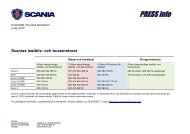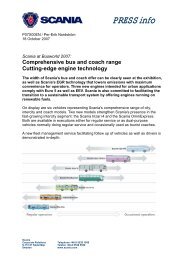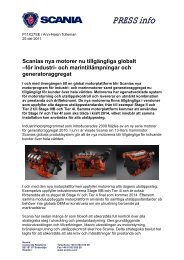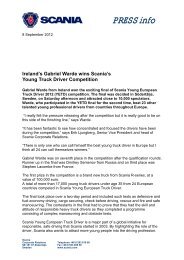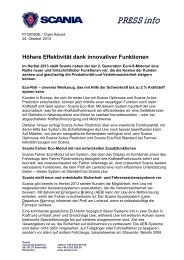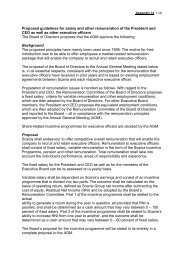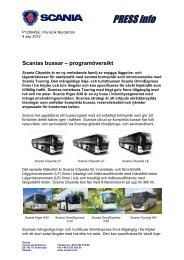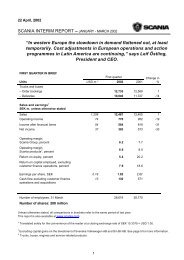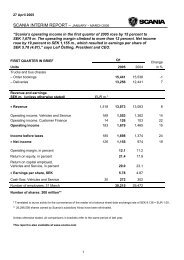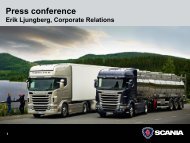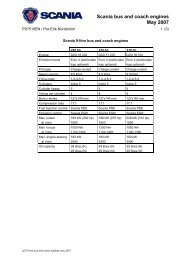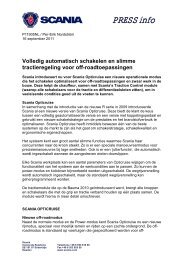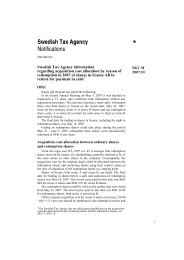Scania annual report 2003
Scania annual report 2003
Scania annual report 2003
Create successful ePaper yourself
Turn your PDF publications into a flip-book with our unique Google optimized e-Paper software.
Accounting principles<br />
The Annual Report of the <strong>Scania</strong> Group has<br />
been prepared in compliance with the Annual<br />
Accounts Act, the current recommendations of<br />
the Swedish Financial Accounting Standards<br />
Council and the statements of its Urgent Issues<br />
Task Force. The recommendations of the Council<br />
are based on the international accounting<br />
principles adopted by the International Accounting<br />
Standards Board.<br />
New accounting recommendations<br />
in <strong>2003</strong><br />
Beginning with <strong>2003</strong>, <strong>Scania</strong> is applying the following<br />
new recommendations issued by the<br />
Swedish Financial Accounting Standards Council:<br />
RR 2:02 Inventories, RR 22 Presentation of<br />
financial statements, RR 24 Investment property,<br />
RR 25 Segment <strong>report</strong>ing – lines of business<br />
and geographic areas, RR 26 Events after the<br />
balance sheet date, RR 27 Financial instruments:<br />
Disclosure and classification and RR 28 Government<br />
grants. The changes in <strong>Scania</strong>’s accounting<br />
principles and in the presentation in the<br />
financial statements resulting from these<br />
recommendations are described below.<br />
RR 25 Segment <strong>report</strong>ing – lines of<br />
business and geographic areas<br />
The operations of the <strong>Scania</strong> Group are managed<br />
and <strong>report</strong>ed primarily by line of business<br />
and secondarily by geographical segments.<br />
<strong>Scania</strong>’s primary segments are Vehicles and<br />
Service plus Customer Finance. These two segments<br />
have distinct products and differentiated<br />
risk situations. The tied-up capital and accompanying<br />
financing structure in Customer Finance<br />
differs substantially from Vehicles and Service.<br />
RR 27 Financial instruments:<br />
Disclosure and classification<br />
Aside from business risks in its operations,<br />
<strong>Scania</strong> is also exposed to financial risks. Information<br />
about these risks as well as <strong>Scania</strong>’s risk<br />
management, including information about the<br />
extent to which derivative instruments are used<br />
for hedging and information about fair value, interest<br />
rate refixing periods and maturity structures<br />
are provided in Note 33.<br />
Consolidated financial statements<br />
The consolidated financial statements encompass<br />
<strong>Scania</strong> AB and all subsidiaries. “Subsidiaries”<br />
refers to companies in which <strong>Scania</strong><br />
directly or indirectly owns more than 50 percent<br />
of the voting rights of the shares or otherwise<br />
has a controlling influence.<br />
Acquisitions of companies are <strong>report</strong>ed<br />
according to the purchase method of accounting.<br />
This means that the assets and liabilities in<br />
the acquired company are accounted at acquisition<br />
values assigned by the purchaser according<br />
to the acquisition analysis. If the acquisition<br />
value of the shares exceeds the value of the<br />
company’s net assets according to the acquisition<br />
analysis, the difference is <strong>report</strong>ed as goodwill<br />
on consolidation. Only earnings arising after<br />
the date of acquisition are included in the shareholders’<br />
equity of the Group. Divested companies<br />
are included in the consolidated financial<br />
statements until and including the divestment<br />
date.<br />
Minority interests in net income and shareholders’<br />
equity are <strong>report</strong>ed separately.<br />
Associated companies<br />
“Associated companies” refers to companies<br />
in which <strong>Scania</strong> has a long-term ownership interest<br />
and possesses a significant influence.<br />
Associated companies are accounted for using<br />
the equity method. This means that in the consolidated<br />
financial statements, holdings in associated<br />
companies are valued at the Group’s<br />
share of the shareholders’ equity in the associated<br />
company after adjusting for the Group’s<br />
share of surplus and deficit values, respectively.<br />
In this way, <strong>Scania</strong>’s share of the earnings in an<br />
associated company is included in consolidated<br />
earnings.<br />
Foreign currencies<br />
When preparing the consolidated financial statements,<br />
all items in the income statements of<br />
foreign subsidiaries are translated to Swedish<br />
kronor using the average exchange rates during<br />
the year. All balance sheet items, except net income,<br />
are translated using the exchange rates<br />
on the respective balance sheet date (closing<br />
day rate). This method is usually called the current<br />
method. The changes in the shareholders’<br />
equity of the Group that arise due to different<br />
exchange rates on the closing day compared<br />
to the exchange rate on the preceding closing<br />
day are <strong>report</strong>ed directly against shareholders’<br />
equity. Aside from industrial operations in South<br />
America and some markets in eastern Europe,<br />
the functional currency of all subsidiaries is the<br />
same as the local currency. For the abovementioned<br />
businesses, the American dollar and<br />
the euro, respectively, have been used as the<br />
functional currency. The reasons for this have<br />
been that cost and price levels have had a high<br />
correlation to the dollar and euro, respectively.<br />
Items (transactions) in local currencies have been<br />
translated into the functional currency using the<br />
monetary/non-monetary method, after which a<br />
translation from the functional currency to Swedish<br />
kronor occurred using the current method.<br />
Receivables and liabilities in foreign currencies<br />
are valued at the closing day rate. In applicable<br />
cases, receivables and liabilities are valued<br />
at the underlying hedging rate.<br />
Currency forward contracts entered into<br />
in order to hedge future commercial currency<br />
flows are <strong>report</strong>ed among earnings on the same<br />
date that the commercial flow was realised. Premiums<br />
received or paid for currency options that<br />
are intended for hedging of currency flows in<br />
business transactions are <strong>report</strong>ed as income<br />
or expenses over the contract period. Currency<br />
forward contracts that do not meet the criteria<br />
for hedge accounting are valued according to<br />
the lower of cost or net realisable value.<br />
When valuing financial assets and liabilities<br />
where the original type of currency was changed<br />
through a currency swap, the loan amount is<br />
translated to Swedish kronor taking into account<br />
the swap agreement.<br />
Exchange rate differences on loans and other<br />
financial instruments in foreign currencies that<br />
are intended for hedging of foreign net assets<br />
are <strong>report</strong>ed directly against shareholders’ equity.<br />
Classification in the balance sheet<br />
<strong>Scania</strong>’s operating cycle, that is, the time that<br />
elapses from the purchase of materials until<br />
payment for goods delivered is received, is less<br />
than twelve months. This means that a current<br />
liability is a liability that falls due for payment within<br />
twelve months, counting from the balance<br />
sheet date. Other liabilities are classified as longterm.<br />
Current assets are assets that are expected<br />
to be realised within twelve months, counting<br />
from the balance sheet date, or that consist of<br />
liquid assets. Other assets are classified as fixed<br />
assets.<br />
Classification of financial and operating<br />
leases (<strong>Scania</strong> as lessor)<br />
Leasing contracts with customers are <strong>report</strong>ed<br />
as financial leases in cases where substantially all<br />
risks and rewards associated with ownership of<br />
the asset have been transferred to the lessee.<br />
Other leasing contracts are classified as operating<br />
leases and are <strong>report</strong>ed among tangible fixed<br />
assets.<br />
Valuation principles<br />
Assets, liabilities, provisions and derivatives have<br />
been valued at acquisition value unless otherwise<br />
stated.<br />
Tangible fixed assets<br />
Tangible fixed assets are <strong>report</strong>ed at acquisition<br />
value minus accumulated depreciation and any<br />
impairment losses. If a tangible fixed asset includes<br />
major components with a divergent useful<br />
life (depreciation period), these are <strong>report</strong>ed as<br />
separate assets.<br />
Depreciation is mainly carried out on a<br />
straight-line basis over the estimated useful life<br />
of an asset. In those cases where a residual<br />
value exists, the asset is depreciated down to this<br />
value. Useful life and depreciation methods are<br />
taken into consideration regularly and adjusted in<br />
case of changed circumstances. The following<br />
useful life is applied:<br />
Machinery and equipment 5–15 years<br />
Industrial buildings<br />
25 years<br />
Land assets<br />
No depreciation<br />
Depreciation is charged to earnings for the<br />
period. If there is any indication on the balance<br />
sheet date that a tangible asset has diminished in<br />
57 ANNUAL REPORT <strong>2003</strong>



